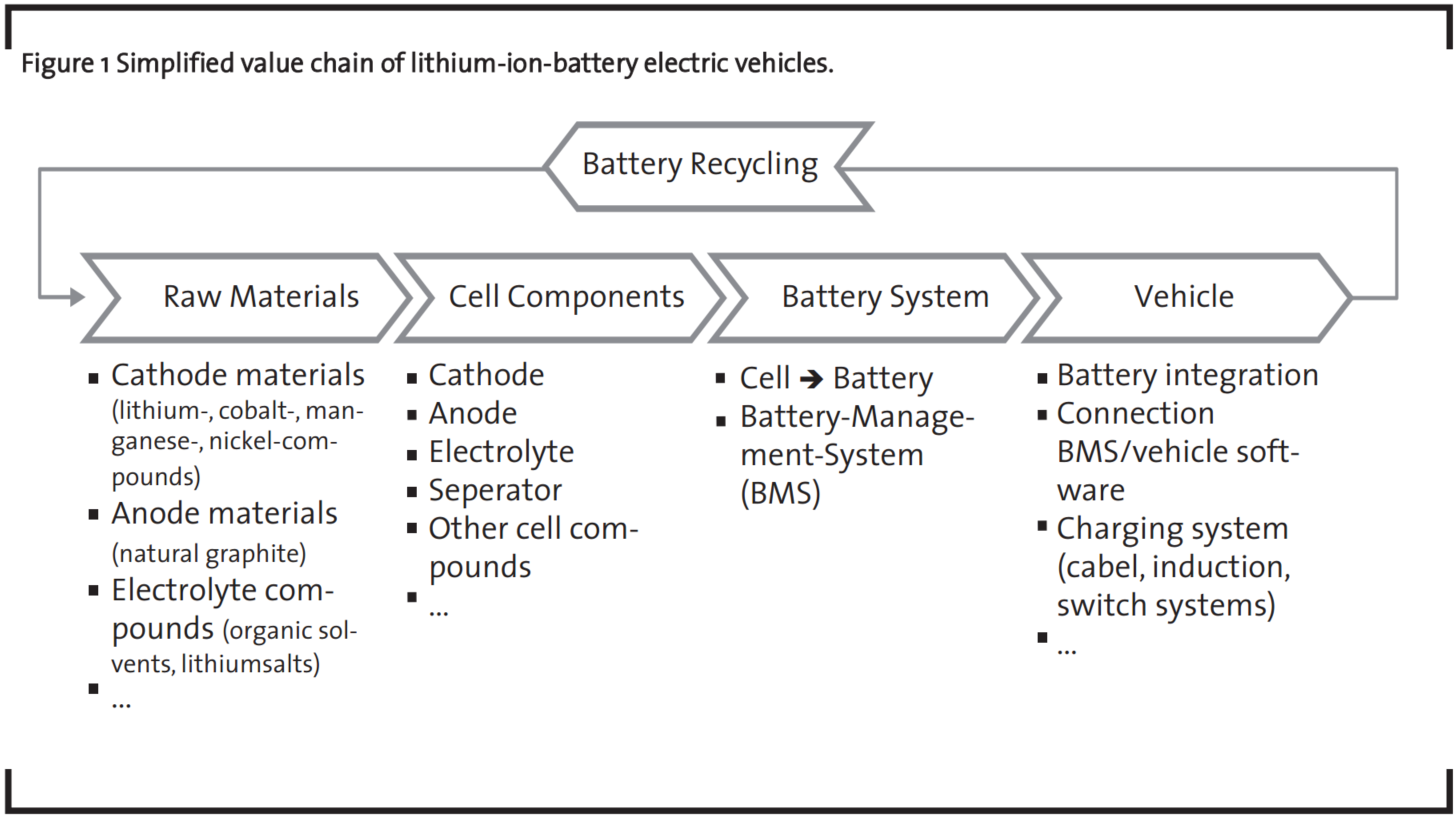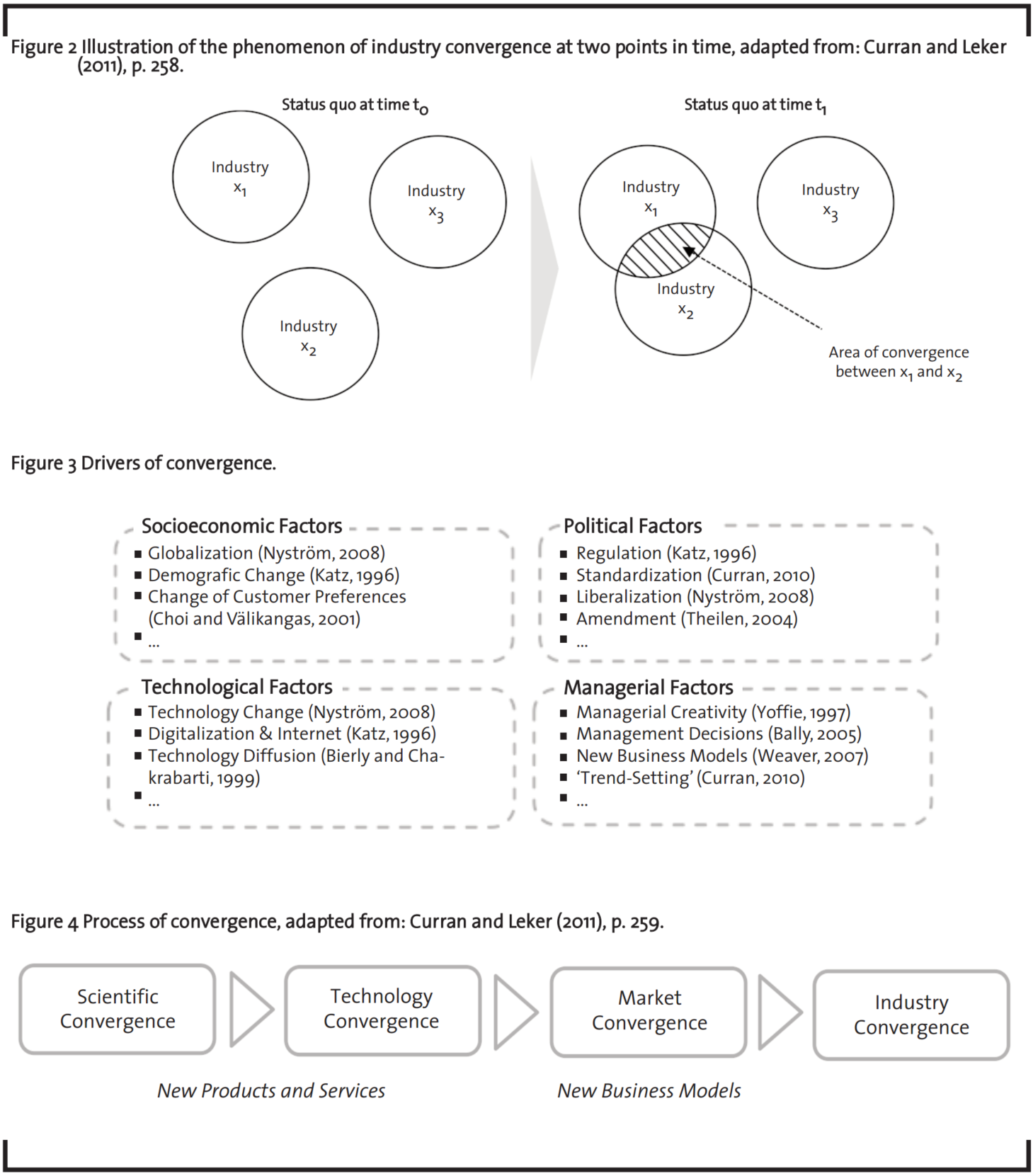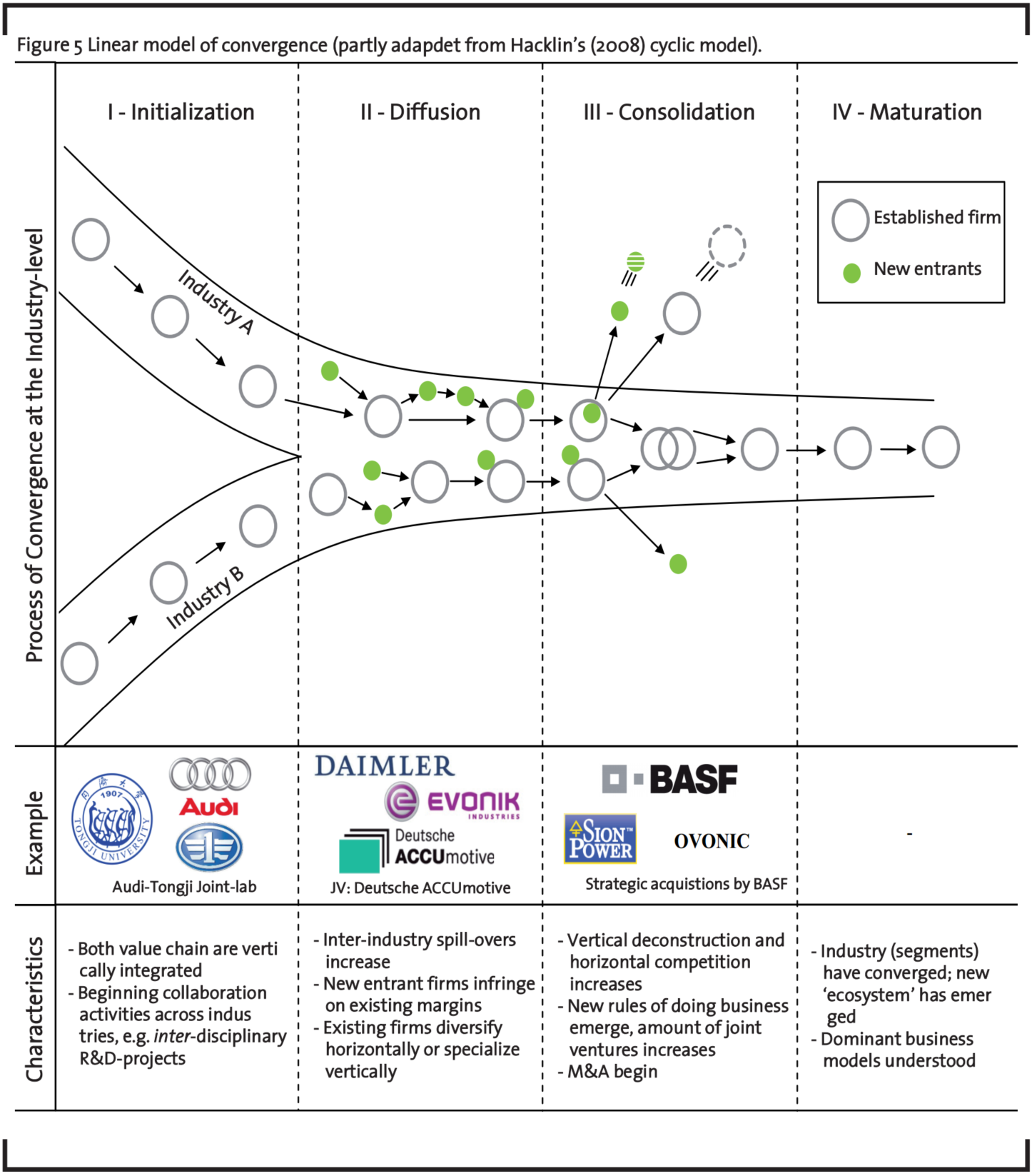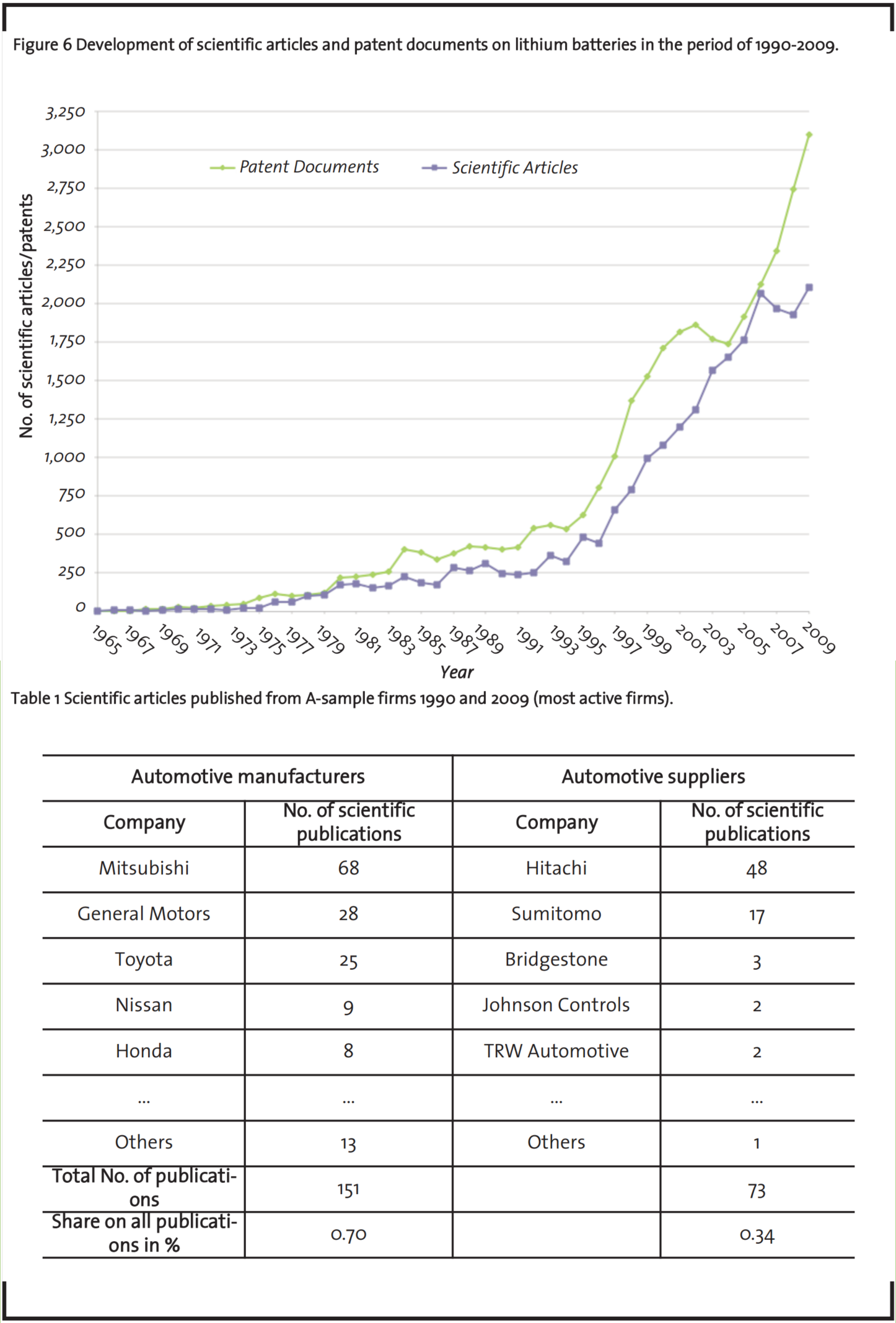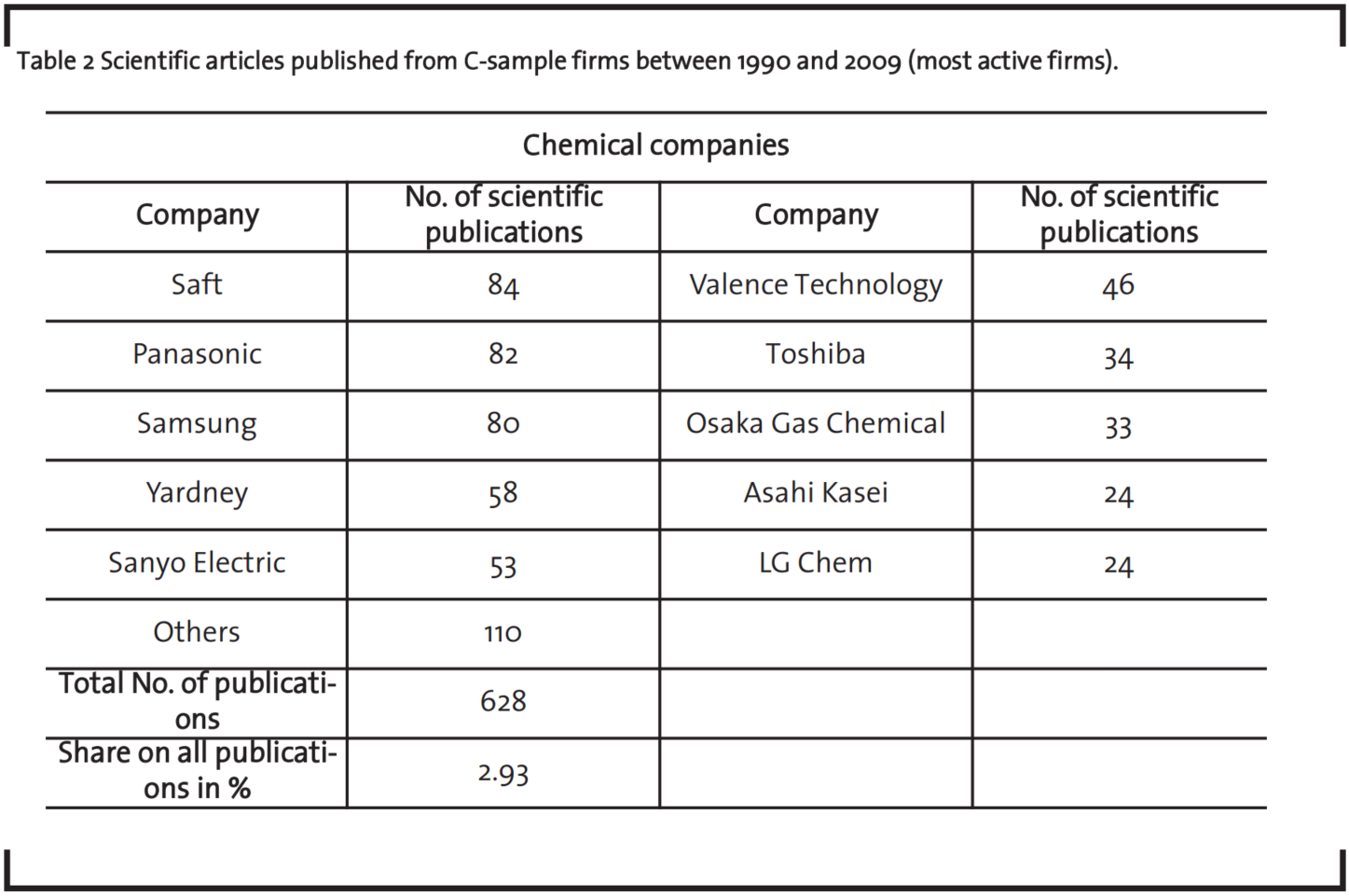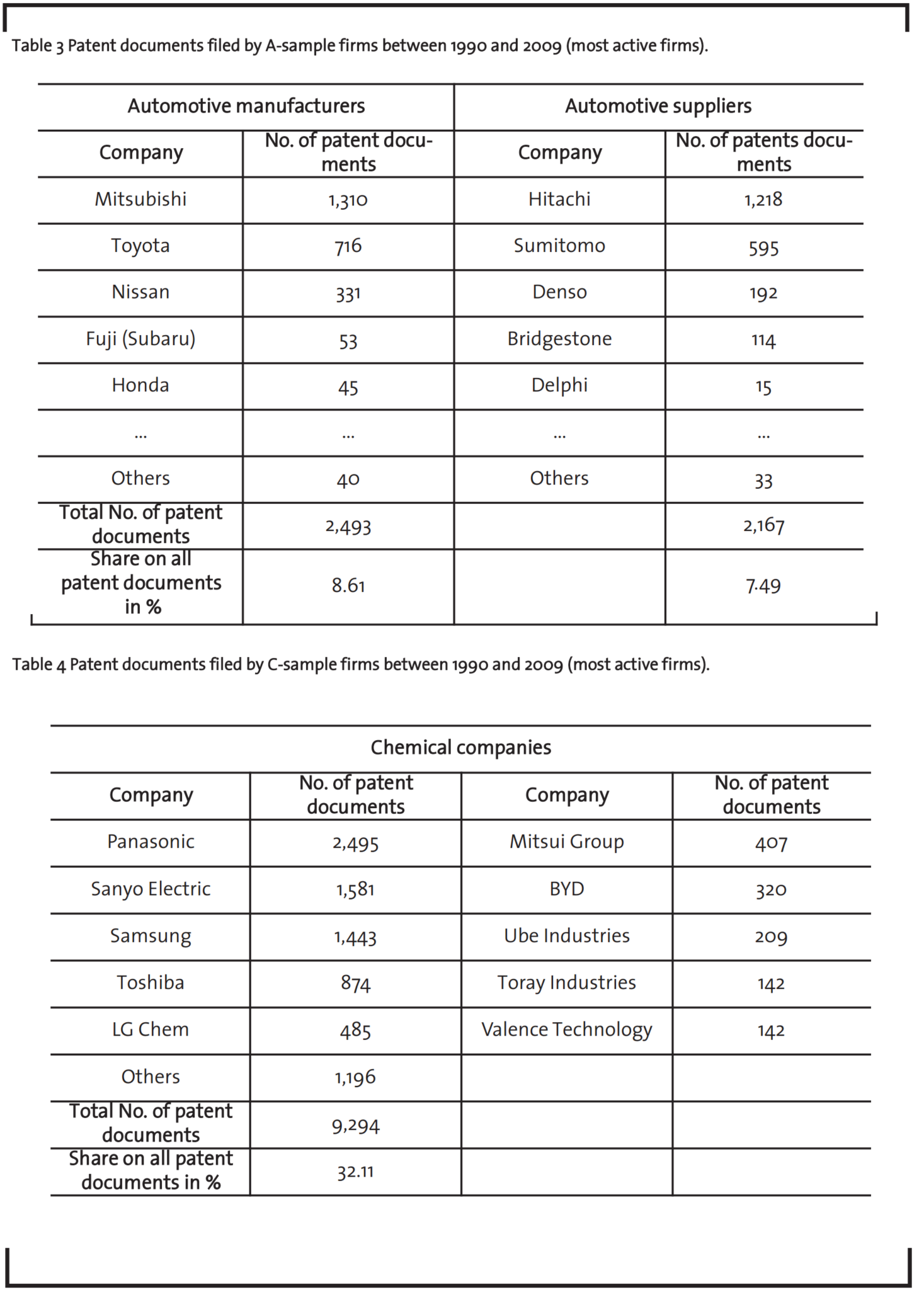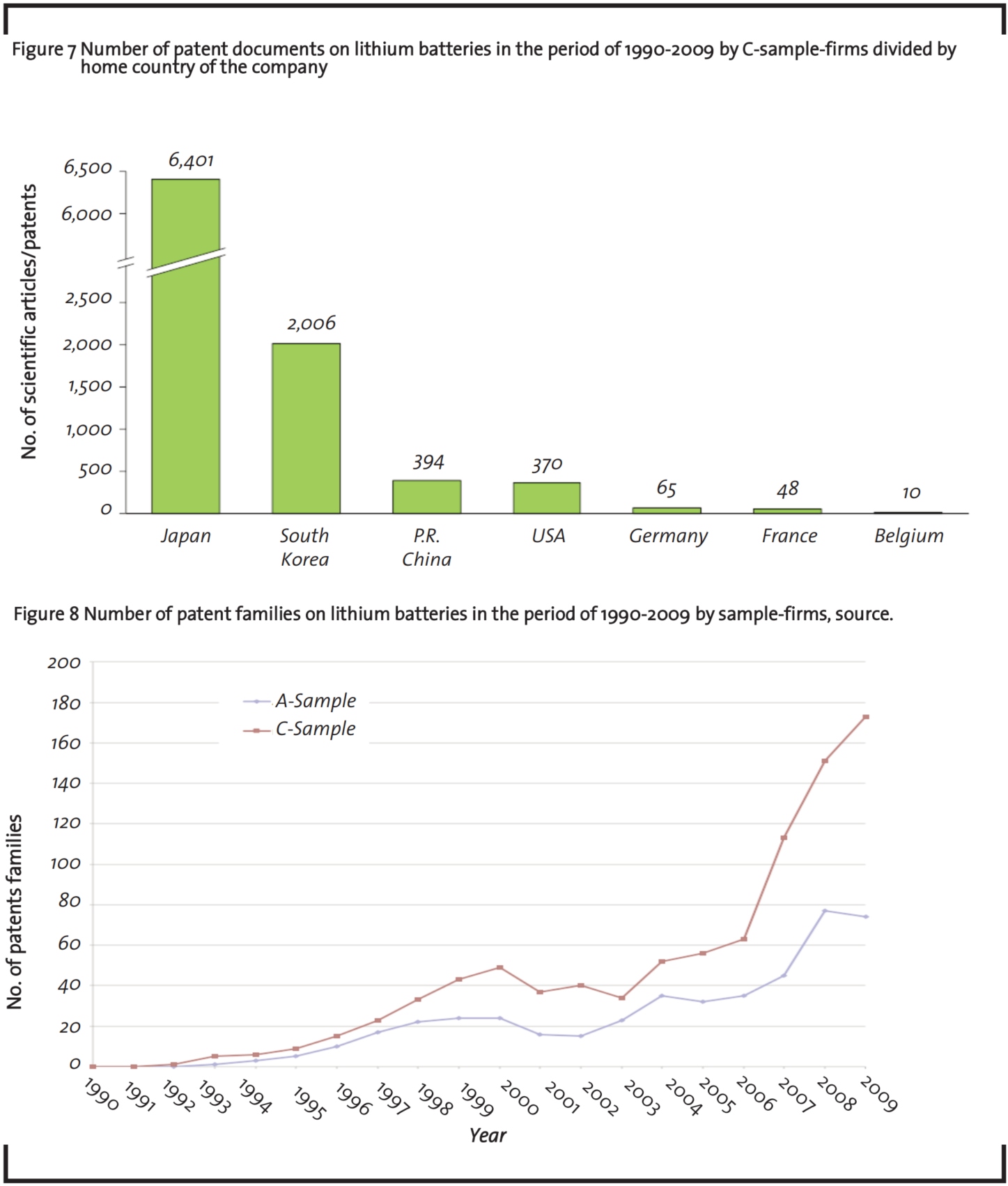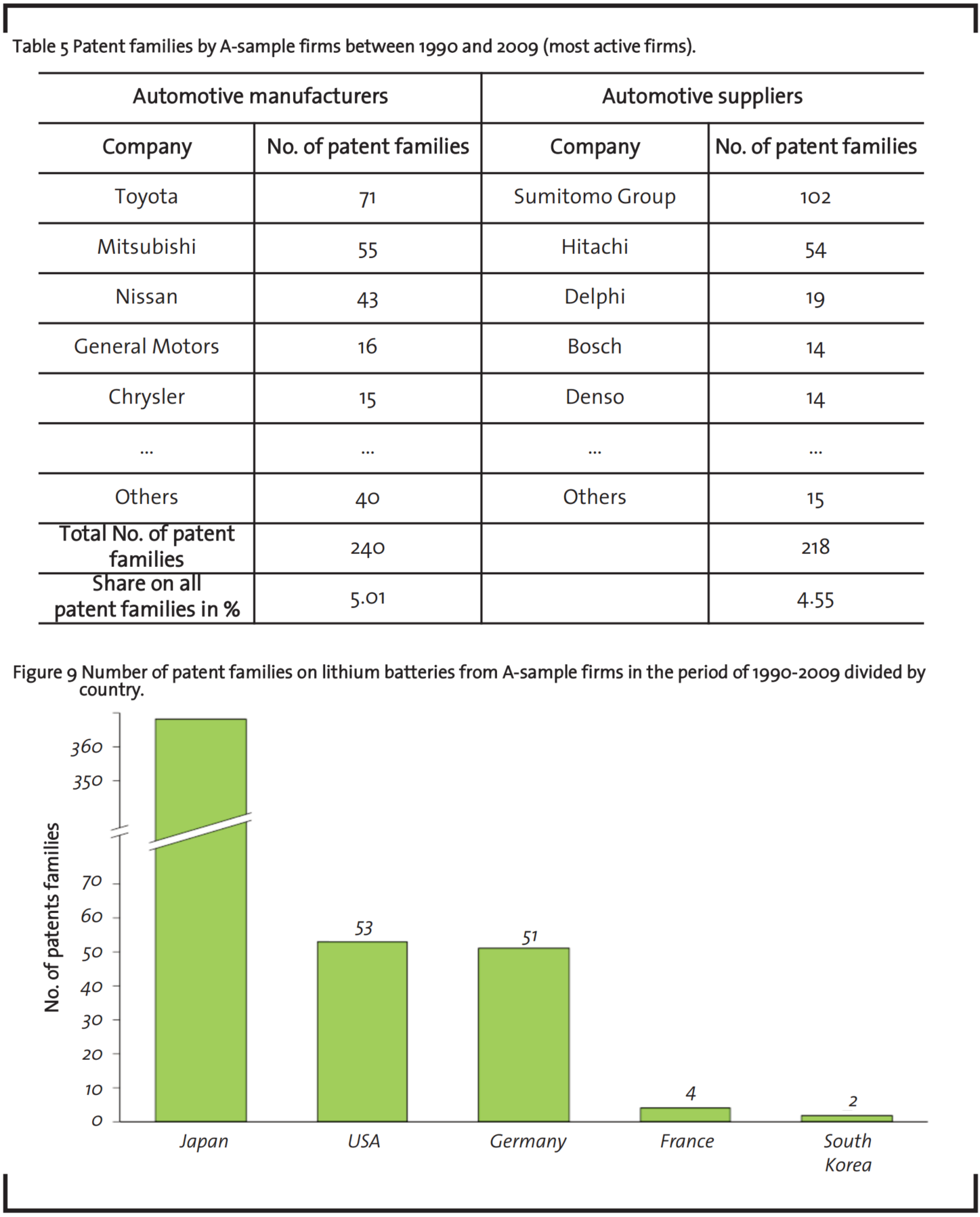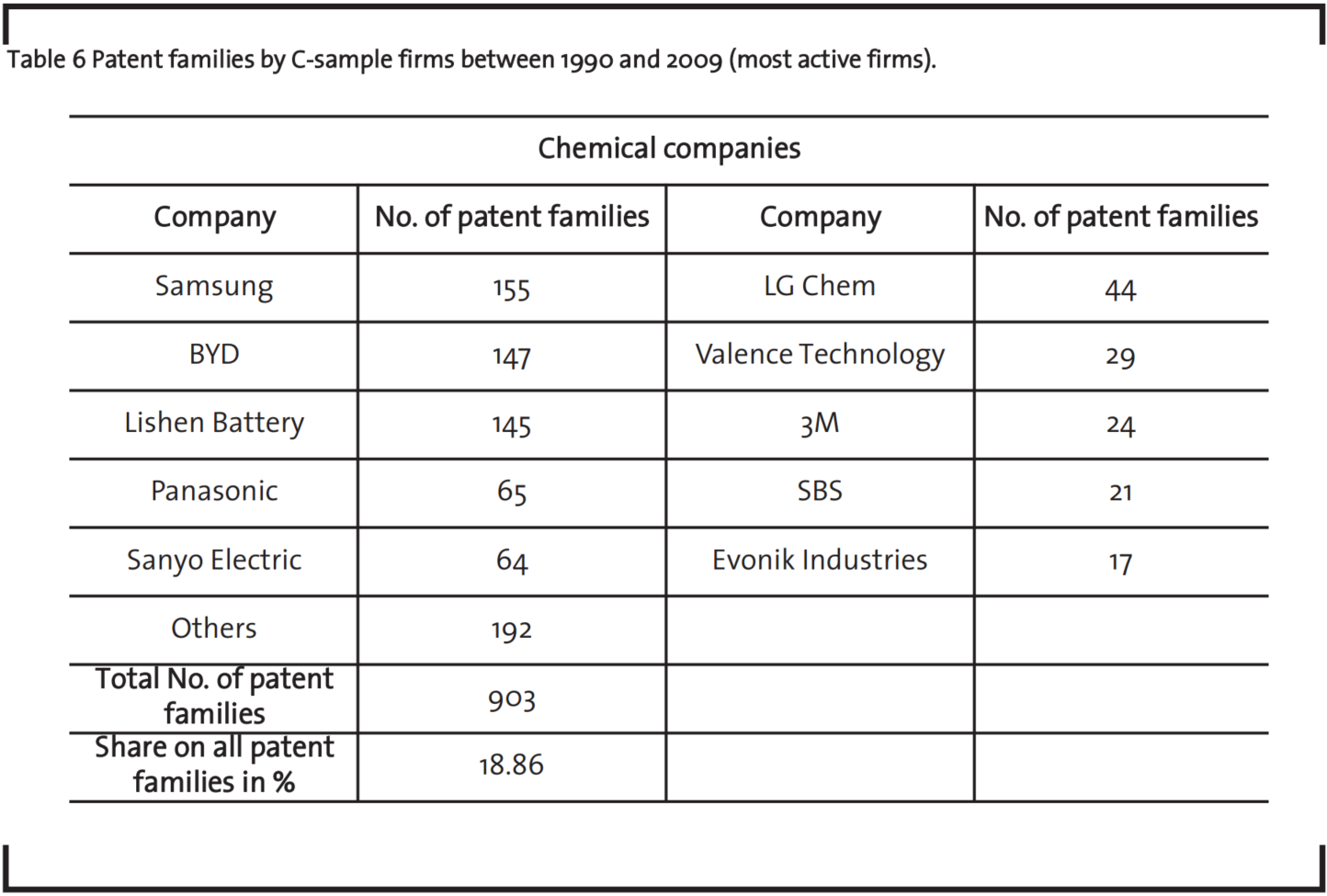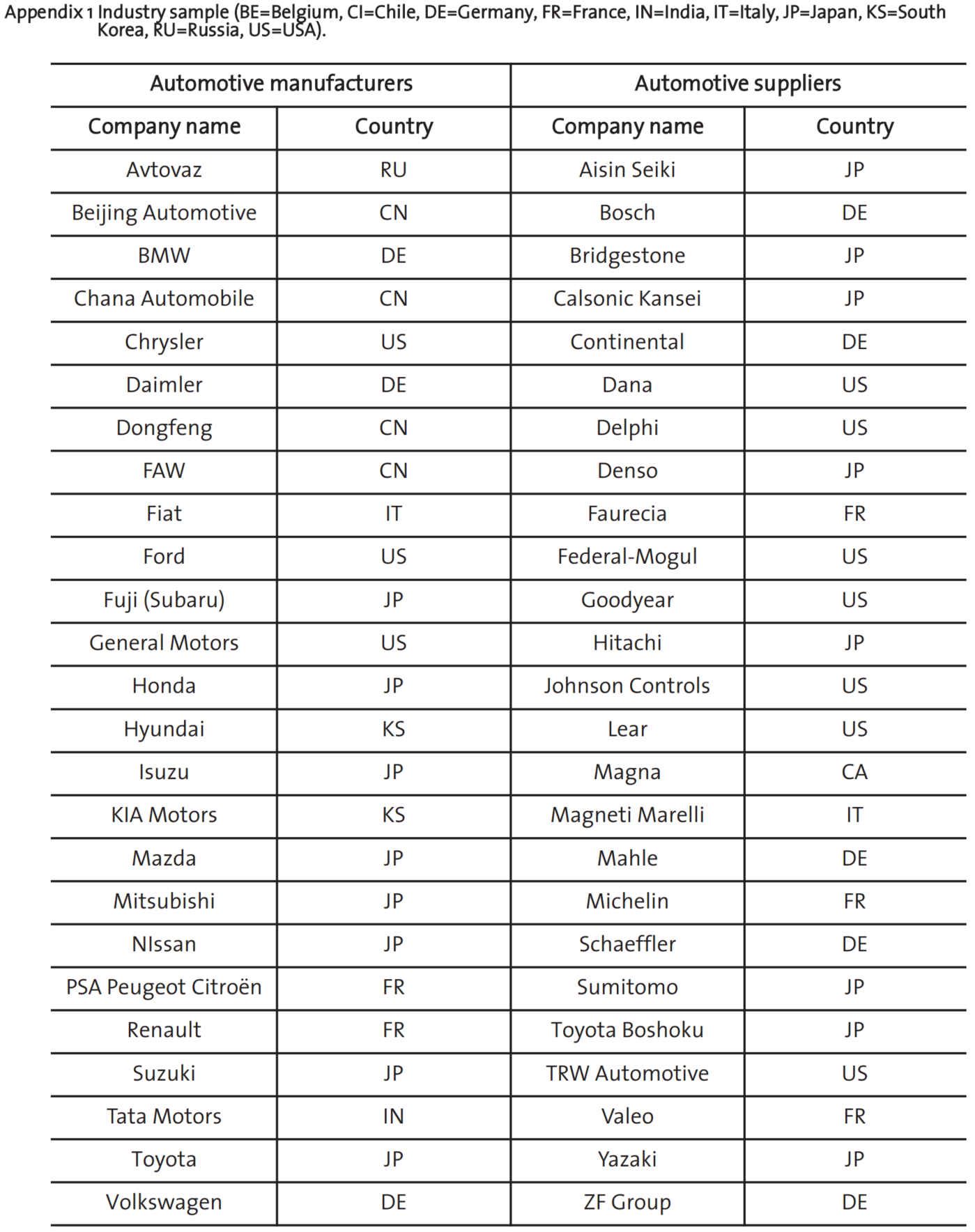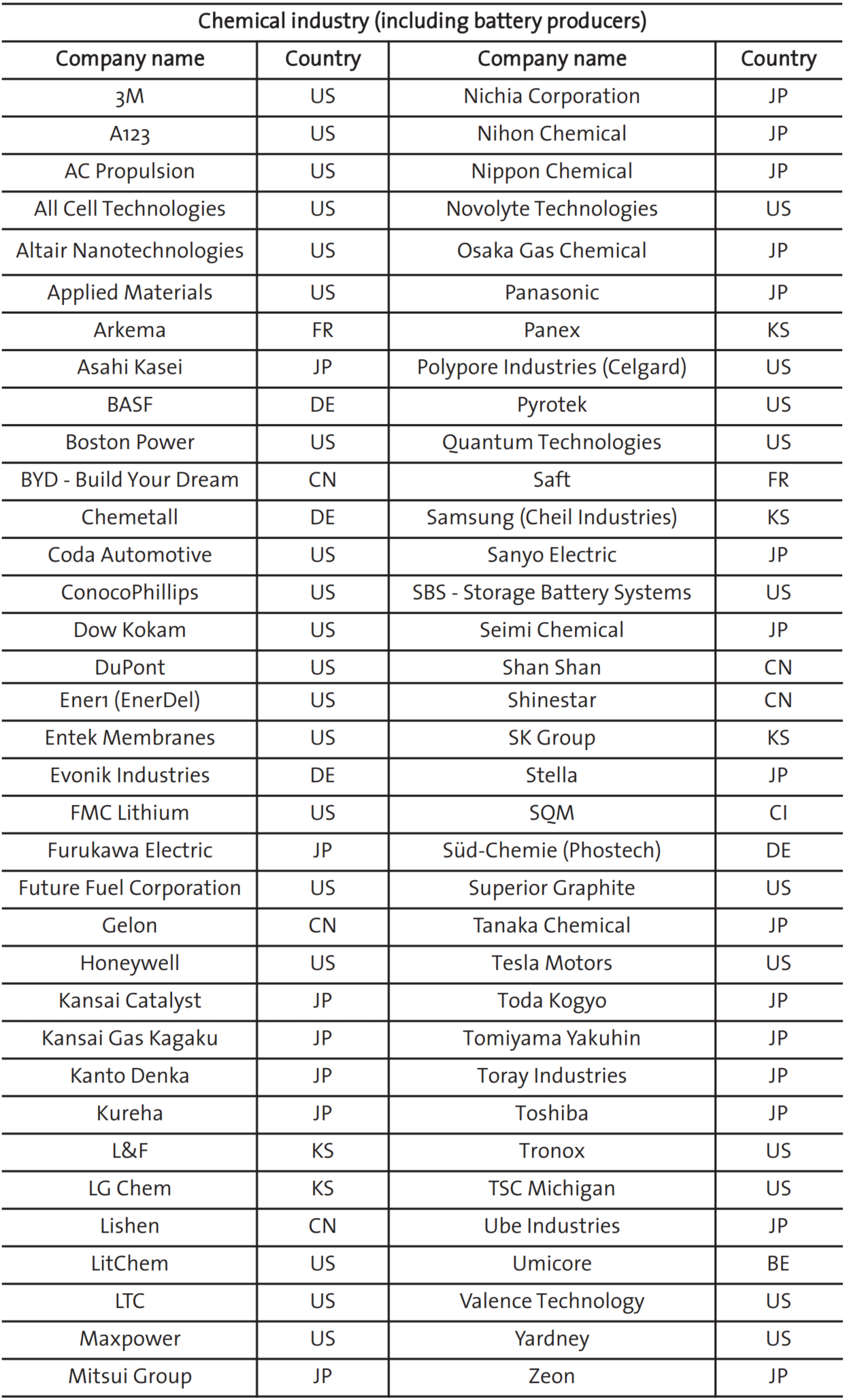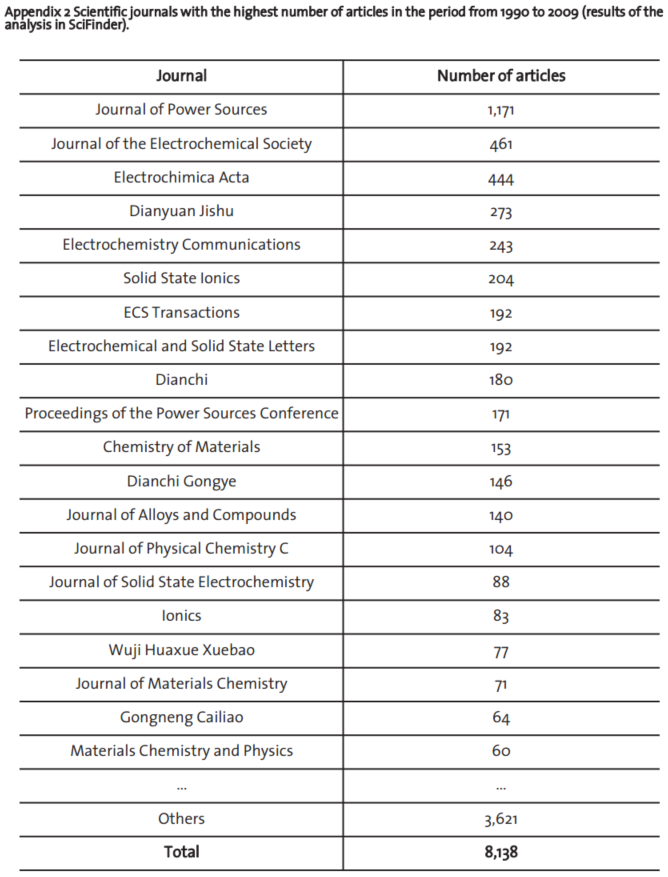Inter-industry innovations in terms of electric mobility: Should firms take a look outside their industry?
Abstract
The beginning electrification of the automotive powertrain is supposed to have a major impact on the automobile value chain – reshaping it significantly and bringing up new alliances, business models and knowledge bases. Such a transformation of the value chain might fade boundaries between hitherto distinct knowledge bases, technologies, or industries. Over the past decades, the blurring of industry boundaries – the phenomenon of industry convergence – has gained attention from researchers and practitioners. The anticipation of a convergence process plays an important role for strategic and innovation management decisions, e.g. for new business development, mergers and acquisitions or strategic partnerships. However, despite the relevance of convergence, it is often challenging for incumbent firms to (1) foresee such a transformation of their environment, and (2) respond strategically to it. Hence, this study presents a tool to anticipate convergence and strategic implications are discussed.
1 Introduction
Technological change is known as a key driver of economic growth and prosperity (Schumpeter, 1947; Abernathy and Utterback, 1978; Kondratieff, 1979). From the first steam engine to the latest developments in nano- and biotechnology, companies have constantly benefited from and proactively promoted the development of new technologies and scientific research. A special phenomenon of technological change is known as industry convergence. Traditionally, it has been associated with the fading of industry boundaries between information technologies, consumer electronics and telecommunication (ICT) (Duysters and Hagedorn, 1998; Pennings and Puranam, 2001). Recently, convergence has also been observed in other industries, e.g. the chemical, pharmaceutical, and food industry (Bröring et al., 2006; Curran and Leker, 2009a). When hitherto distinct industries converge, the emergence of technological innovations at the borderline of these industries brings up new applications and combinations, resulting in a situation where “established paradigms will be replaced by new ones […] and thereby disrupt and substitute rules of conducting business” (Hacklin et al., 2009, p. 723). Firms facing such a situation, thus have to adapt to new knowledge bases and new technologies which do not belong to their former core competences or their traditional expertise (Curran and Leker, 2011). Scholars reason that this assimilation of knowledge and technology is a key factor for successful innovation management in converging industries (Bierly and Chakrabarti, 2001). Hence, the anticipation of convergence plays an important role for management decisions, like new business development, mergers and acquisitions, or strategic research and development (R&D) partnerships. But how can firms anticipate the blurring of industry boundaries and, thus know if they should take a look outside their industry? And what consequences do blurring industry boundaries have for firm’s strategic and innovation management?
Taking the current trend of battery electric vehicles as an example, I used a bibliometric analysis of patents and scientific publication as an indicator for a beginning convergence process between the automotive industry, producing electric vehicles, and the chemical industry, producing batteries and battery components for those vehicles.
Based on this quantitative analysis, I deduce basic implications for strategic and innovation management in the field of electric vehicles. Recent examples from the automotive and chemical industry are used to support the concept of this study.
The remainder of this paper is organized as follows. In the next two sections the ongoing debate on battery electric vehicles and theoretical developments relating to industry convergence are summarized. Section 4 explains the methodology applied in research; and section 5 presents the results of the analysis. The paper concludes with a discussion of the findings and future research opportunities.
2 Electric mobility
The automotive industry has a long-standing history and denotes one of the most important pillars of our economy. However, global trends, such as emerging markets, increasing political regulation, climate change and increasing oil prices have forced automotive companies to combine their traditional businesses with innovative ways of energy supply (Drapcho et al., 2008; Nag, 2008; Booz & Company, 2009; Deutsche Bank, 2009). The result is an increasing degree of electrification in the automotive industry called electric mobility1 and captured by the catchphrase “e-mobility”. Some scholars focus on the electric engine of a vehicle and the electric energy source when they refer to electric mobility (Möller, 2010), while others like the IEA (2009), Canzler and Knie (2010) and Karg and Reinhardt (2010) have a broader understanding of electric mobility. Instead of solely focusing on the change from internal combustion to electric power supply, they define electric mobility as a new traffic system, with new infrastructure, so called “smart” electric grids, as well as new business models. Others again, like Schill (2010) argue that there is no clear definition of electric mobility. In this work, I focus on battery electric vehicles. The importance of the vehicle-grid-connection and the potential impact of other electric vehicles types, e.g. fuel cell electric vehicles, should thereby not be reduced.
The electrification of the powertrain is considered to be one of the most fundamental technological changes for the automotive industry. The consulting company McKinsey for example observes a “dramatic shift in the value chain, affecting market fundamentals and required competences” (McKinsey, 2011, p. 9), while Boston Consulting identifies the emergence of new business models, e.g. business models that are built around leasing concepts (BCG, 2010). Roland Berger concludes that new players will appear along the value chain, intensifying competition, and reshaping the business landscape (Roland Berger, 2009). This reshape of the entire automobile value chain is estimated to include skill shifts from mechanics to battery chemistry and electronics (McKinsey, 2011), as well as an intensified competition (McKinsey, 2009). This transition calls for the development of a new knowledge base which can only be achieved through strategic partnerships and innovation alliances (Capgemini, 2009), as the required competences, e.g. in battery chemistry, would “overburden the R&D departments of a single carmaker” (McKinsey, 2011, p. 14) in terms of fundamental research and financial risks. While consulting companies have been very active in this field, it is remarkably that academia has neglected many managerial aspects of the ongoing debate on electric mobility.
Besides a few exceptions (Mikkola, 2001; Pohl and Yarime, 2012) scientific studies have so far focused on life-cycle costs of electric vehicles (Werber et al., 2009), the dynamics of the interdependencies between car manufacturers and consumers (van Bree et al., 2010; Zhanget al., 2011), or the possible penetration of electric vehicles in specific countries (Weinert et al., 2008; Duke et al., 2009). Based on a patent and publication analysis, I will address this gap and discuss several management challenges, as well as possible strategies to respond to the electrification of the automotive powertrain. To better understand those challenges, I will first give a brief overview of the value chain of battery electric vehicles.
All types of battery electric vehicles use a more or less powerful battery for energy storage, whereby the lithium technology, e.g. lithium-ion- or lithium-air-battery, is a promising candidate (Winter and Besenhard, 1999; Thielmann et al., 2010). This technology is therefore used in the analysis. The simplified value chain of electric vehicles, shown in figure 1, is compared to the traditional automotive powertrain value chain characterized by a significant “chemical part” .
The design of lithium batteries for electric vehicles requires advanced chemical know-how, e.g. in chemical engineering and physical chemistry, because all components are specifically designed for usage in electric vehicles. Therefore, tier-3 and tier-2 firms (raw materials and cell components) are basically chemical companies. Automotive suppliers are positioned on tier-1 (battery integration/assembly) or tier-2 level (electronics for batteries). However, cell electronics must meet the specific requirements of the battery design, which implies a strong connection between automotive suppliers and chemical companies at this level. Since the battery is one of the core elements of national e-mobility strategies, the improvement of the battery in terms of chemical performance and costs is considered to be a critical factor (Blesl et al., 2009). Battery costs are estimated to decline with increasing production numbers (economies of scale) (Becks et al., 2010), yet the absolute cost reduction remains unclear, underlining the uncertainty in this field. National governments have therefore initiated several programs to reduce this uncertainty by supporting market penetration, R&D, as well as the formation of national platforms of interaction between involved actors (automotive and chemical firms, industry associations, unions, universities & research institutions, politicians, and others), e.g. the so called National Platform Electromobility that has been formed by the German government (German Federal Government, 2009). Hence, research and development on lithium batteries for electric vehicles is in the focus of practitioners as well as university scientists. Examples for this attention are newly public-founded battery research programs like TUM CREATE, a joint research program between the Technical University of Munich and Nanyang Technological University (TUM, 2013), industry joint ventures like Li-Tec Battery by the automotive company Daimler and the chemical company Evonik (Li-Tec, 2013), and corporate spin-offs like Maxell Energy by Hitachi Maxell (Hitachi Maxell, 2011). According to McKinsey, companies aim to achieve a first-mover-advantage with those actions.
3 Industry convergence
3.1 Definition and drivers
Several definitions of the term “convergence” exist. However, a clear ex antedefinition of “convergence” and a conceptual delineation from the term “industry convergence” has started only in the late 1990s. Scholars argue that due to this late clarification, convergence has rather become a buzzword, especially in ICT, than a scientific term (Lind, 2004; Curran and Leker, 2011).
Rosenberg was one of the first who used the term convergence to describe technological changes between machinery and metal-using sectors (Rosenberg, 1963). A well-known definition was later given by the OECD defining convergence as “the blurring of technical and regulatory boundaries between sectors of the economy” (OECD, 1992, p. 13). Following this definition, Choi and Välikangas describe convergence as the blurring of “boundaries between industries by converging value propositions, technologies, and markets” (Choi and Välikangas, 2001), while Pennings and Puranam define convergence as “the erosion of boundaries that define and isolate industry-specific knowledge” (Pennings and Puranam, 2001, p. 3). These definitions do not clearly distinguish between convergence in general and industry convergence in specific. In this study convergence is therefore defined as a generic term for a process characterized by blurring boundaries between objects. In the case of industry convergence, objects are industries (in figure 2 overlapping circles are used to illustrate this phenome non). Other loci of convergence can be scientific disciplines, technologies or markets. Distinguishing between these different levels of convergence implies to view convergence as a process, rather than as a single event.
Before I will give a more detailed description of this process-view, I will briefly describe what triggers and drivers of convergence have been identified in the literature.
Similar to the drivers of electric mobility, socioeconomic factors, e.g. demographic change, new customer value propositions and globalization, have been mentioned as drivers of convergence (Choi and Välikangas, 2001; Hacklin, 2008; Nyström, 2008). Furthermore political factors, like regulation and liberalization, as well as technological factors, like digitalization and the growing importance of the internet in case of ICT, are known as drivers of the convergence process (Katz, 1996; Theilen, 2004; Bröring, 2005). Scholars also highlight the role of management decisions as individual business actions, framed “managerial creativity” (Yoffie, 1997, p. 9) or evolutionary “business thinking” (Katz, 1996, p. 1083) resulting in new business models, may initiate the convergence of markets or industries. Introducing the iPhone with its new design and functionality, and the combination to the established iPod/iTunes business model, is an example for how new products in combination with attractive business models can drive convergence (Johnson et al., 2008; Curran and Leker, 2009b). Figure 3 gives an overview of drivers of convergence.
3.2 Convergence as a process
The process-based view of convergence was first introduced by Hacklin. Based on several case studies, he uses an “evolutionary and sequential perspective” to divide the process of convergence into four steps: (1) knowledge convergence, described as a spill-over between industrial knowledge bases that were previously unassociated, (2) technological convergence, i.e. the transition of converged industrial knowledge into industrial technologies, (3) applicational convergence, a phase where “opportunities for new value creation” emerge, and (4) industrial convergence, described as a situation of cross-industrial competition and “collision of business models” (Hacklin, 2008). The erosion of industry specific knowledge in phase (1) is characterized as an “autonomous and serendipitous” external effect for firms. However, this does not mean that firms have no options to response to knowledge convergence: the formation of crossorganizational and multidisciplinary teams is for example a way to respond to the blurring of knowledge boundaries. If this blurring leads to new technologies, the level of technology convergence has been reached. New ways of value creation are formed if these new technologies can be applied to solve customer problems that have previously been unsolved, or if they solve existing problems in a better way. Management decisions in this phase of applicational convergence can be seen as the foundation pillars of economic success in the future, because new technologies have to be integrated and existing competences have to be extended. This development can finally result in a new competitive environment, since a new industry structure with new rules of doing business, e.g. new distribution channels, occurs. While Hacklin’s view offers new insights, the focus on firms and industries in the phases of knowledge and technological convergence excludes developments outside industry, e.g. in academia. Furthermore the difference of industrial knowledge and industrial technology remains unclear. Therefore, a broader definition of knowledge and technology has been introduced by Curran (2010). Because convergence has mainly been observed and associated with knowledge- and technology-intensive industries, he argues, that convergence can first be observed in the blurring of the boundaries between different scientific disciplines, therefore called science convergence. This “coming together” of hitherto distinct scientific disciplines can be seen in interdisciplinary research collaborations. For instance, chemists, physicist, and engineers work jointly together at the Helmholtz Institute Ulm for electrochemical energy storage or the Münster Electrochemical Energy Technology battery research center (MEET, 2009; HUI, 2011). Following the innovation value chain, areas of basic research converge first, followed by applied and industrial research. The converging of science areas may then result in new technologies, which can be turned into new product-market combinations using new business models (market convergence). If entire industries or industry segments converge the stage of industry convergence has been reached.
In this paper, Curran’s approach is applied. At this point, it is important to understand that the described process of convergence (1. science convergence, 2. technology convergence, 3. market convergence, 4. industry convergence) is not necessarily linear; it is more a simplified and idealized time series of events (see figure 4).
Curran’s model of the convergence process explains many of the effects that can be observed in convergence, e.g. forming of new knowledge bases or new product-market combinations, but it does not describe how the change of industry boundaries is taking place at the industry-level. Such models of change are not new (e.g. Anderson and Tushman, 1990), but Hacklinet al.(2009) were the first who adapted such a model to explain the process of convergence as an idealized sequence of events at the industry-level. Hacklin (2008) originally introduced a cyclic model of convergence, however, for this study a simplified linear model will be used to illustrate the managerial challenges during industry convergence2. As illustrated in figure 5 the linear model consist of four sequential phases: (I) initialization, (II) diffusion, (III) consolidation, and (IV) maturation.
In the initial state, different vertical integrated industries (or industry segments) undergo structural changes, e.g. driven by new technologies or new regulations, independently. Industries may react differently to external influences, e.g. by forming intra-industrial collaborations or research partnerships with academia. For instance, the German car manufacturer Audi, the Chinese car manufacturer FAW, and the Tongji University have established a joint-lab for electric mobility in Shanghai (Tongji University, 2010). According to Audi chairman Rupert Stadler, the company co-founded this lab because “China is an important driver for electromobility. That is why we are investing locally…” (CER, 2010). The next stage is characterized by inter-industrial transitions, diffusing industrial boundaries. Established firms start to diversify horizontally or specialize vertically, while new firms enter the market and start to compete with incumbents. The previously unconnected industries “move closer together”. Joint ventures between companies from the previously distinct industries can be observed during this diffusion. In 2009, the Deutsche ACCUmotive was for example formed as a joint venture between the car manufacturer Daimler and the chemical company Evonik Industries to develop and produce battery systems for electric vehicles (Deutsche ACCUmotive, 2013). The situation of intensified competition as well as inter-industry collaboration then results in a phase of consolidation where mergers and acquisitions take place or firms may be phased out of the market, i.e. they undergo a reorientation to other markets (or segments) or they went bankrupt. The chemical company BASF has for instance acquired an equity ownership position for $50 million in the US battery company SION Power and acquired the US company Ovonic Battery for $58 million (BASF, 2012a; BASF, 2012b). According to Frank Bozich, President of BASF’s global catalysts division, the acquisition aims to support BASF’s strategy to become the “leading provider of functional materials and components to serve cell and battery manufacturers worldwide” (BASF, 2012a). Another example reflecting this phase is this year’s acquisition of all non-government business assets of the financially stricken US battery company A123 Systems by Wanxiang America Corp. (A123, 2013). Previously, Johnson Controls acquired A123’s automotive business assets, including all of its automotive technology, products, and customer contracts in a transaction valued at $125 million (A123, 2012). After the phase of consolidation, in phase IV, a new industry structure (or industry segment structure) emerges and the convergence process is completed.
3.3 Anticipation of convergence
Market and industrial change is considered to be a key source of innovation (Drucker, 1998). Hence, it is especially relevant for incumbent firms to monitor a potential convergence process in their industry and prepare as early as possible for such a radical change of their environment. However, according to Cohen and Levinthal (1990) and Trott (1998), only a few firms are able to scan their environment. It is therefore useful to provide the management of firms with a “scanning-tool” that allows firms to anticipate a possible convergence process in their industry. Such an anticipation method for science and technology convergence has been developed by Curran et al. (2010) on the basis of publicly available data. As mentioned in the previous section, science convergence can be observed by means of interdisciplinary research collaborations. When researchers from different science areas collaborate, research results are jointly published in scientific journals. Co-citations and co-authorships can indicate science convergence, as researchers conduct research interdisciplinary and start to cite publications from other science disciplines. When the process of convergence proceeds, signs of technology convergence have to be examined. Patents have a stronger technological focus than other publications and are considered to be a key competitive advantage in technology intense industries (Hall, 1993; Newbert, 2008). When technology-areas converge and new technology-bases emerge, firms start to patent outside their traditional expertise. Therefore the analysis of patent-activities outside the knowledge-base of a firm, co-authorships and co-classifications (international patent classifications for example) are a suitable way to identify signs of technology convergence.
4 Methods
To detect signs of a beginning convergence process between the automotive and the chemical industry in the field of electric cars, a bibliometric search-term-based-analysis of scientific publications and patents was used in this study. “Lithiumion battery/batteries” (covering existing lithium battery technologies), and “lithium battery/batteries” (covering future lithium-based technologies, like lithium-air- or lithium-sulfur-batteries) were used as search terms in SciFinder® and PatBase® in the period from 1990 to 2009. SciFinder® is a web-program provided by the Chemical Abstract Service (CAS) that has access to more than 33 million scientific publications in over 10,000 journals, and patent documents from 63 patent authorities. For providing a high quality of analysis, only reviewed journal articles were analyzed; excluding letters, commentaries, and reports. Because SciFinder® is not designed for extensive statistical patentanalysis3, a program designated for patent analysis was additionally used. PatBase® is a patent-analysis-tool provided by Minesoft Ltd and RWS Group that has access to more than 45 million patent-families from 95 patent authorities. Patent families are “a group of patents which, like a family, are all related to each other, in this case by way of the priority or priorities of a particular patent” (EPO, 2011).
For the analysis, two industry-samples were formed: The first sample (‘A-sample’) includes the 25 largest automotive manufacturing firms (based on the number of produced cars in 2008), as well as the 25 largest automotive suppliers (based on the worldwide revenue of 2008). It is assumed that those 50 companies can play a leading role in the future car market. The chemical industry sample (‘C-sample’) includes 70 companies that have been identified by Lowe et al.(2010) to be the most active companies in the field of lithium batteries for electric cars; starting with raw material suppliers and ending with major battery cell producers. An overview of the firms can be found in appendix 1.
5 Results
5.1 SciFinder®
The first published scientific articles and patent-documents covering the topic of lithium batteries can be tracked back to the year 1965. Since the early 1990s, one can observe a substantial increase in the publication, as well as patenting activity. After removing duplicate entries, the search in SciFinder® resulted in 21,451 scientific articles and 28,940 patent documents in the period from 1990 to 2009.
As expected, the field of scientific publications is dominated by universities and research institutions. Firms from the A-sample published 224 articles between 1990 and 2009, i.e. 1.04% of all scientific publications on lithium batteries in this period. All firms from the A-sample together have fewer publications in 20 years than the Central South University of China – the organization with the highest number of publications in the analysis – in 4 years. Within the sample, car manufacturers, especially Mitsubishi and Toyota, publish more (151 articles) than the automotive suppliers (73 articles). Table 1 shows the most active firms from the Asample. Sample-firms published almost only in chemistry journals, e.g. Journal of Power Sources, whereas only 5% of the articles are published in automotive journals, e.g. Journal of the Society of Automotive Engineers of Japan(see appendix 2 for a list of journals).
The 70 firms of the C-sample published 628 scientific articles in the period from 1990 to 2009, resulting in a share of 2.93% of all scientific publications on lithium batteries in this period. However, 36 firms of the C-sample have not published any articles. The highest number of publications are mainly assigned to companies from Asia, like Panasonic or Samsung, only two US-companies (Yardney, Valence Technology) and one EU-company (Saft – Société des Accumulateurs Fixes et de Traction) are part of the top 10 (see table 2). The three firms with the highest number of research articles primarily publish in chemistry journals (83%) and belong to the tier-1-level (battery, battery-system).
The number of filed patents is, compared to scientific articles, preferably used to determine the commercialization activities in one field. Within the 50 organizations that filed most lithium battery patent documents between 2006 and 2009 are 41 companies and only 4 research institutions (Central South University, Fudan University, Tsinghua University, Korea Electro Technology Research Institute). Not one university appears among the top patent applicants before the year 2000.
Furthermore the analysis in SciFinder® shows that firms from the automotive industry have increased their patent activities in the field of lithium batteries over the past 20 years. Between 1990 and 2000, only two automotive firms are among the top-50 patent applicants, whereas nine automotive firms show high activity from 2006 to 2009. 48% of all patent documents on lithium batteries in the period from 1990 to 2009 belong to the 120 firms from the A- (16%) and C-sample (32%), indicating a high activity in patenting on battery technologies in contrast to the low share of scientific articles.
As can be seen in table 3, automotive manufacturers from Japan, like Mitsubishi, Toyota and Nissan, have a very strong position in respect to the number of filed patents on lithium batterytechnologies. Other manufacturers have less than 10 or no patent documents on lithium batteries. A similar situation can be observed on the side of automotive suppliers where a few firms from Japan have top positions in the ranking.
Firms from the C-sample hold 9,294 patents. Among the 20 most active companies of the Csample are 13 from Asia (Panasonic, Sanyo Electric, Samsung, Toshiba, and LG Chem). Valence Technologies, 3M, and A123 are the firms from the US, while Saft, BASF, and Evonik Industries are the European firms with the highest number of patent documents. Table 4 and figure 7 show the results of the C-sample-analysis.
5.2 PatBase®
The analysis in PatBase® in the period from 1990 to 2009 results in 4,789 patent families on lithium battery technologies. Within the 50 organizations with the highest number of patent families are 47 companies and only 3 research institutions (Fudan University (P.R. China), Institute of Physics of the Chinese Academy of Science (P.R. China), and the Centre National de la Recherche Scientifique (France)).
Firms from the two industry-samples have a share of 30% (1,316) on all patent families on lithium battery technologies. Within the A-sample, automotive manufacturers hold 240 patent families (5.01%) and automotive suppliers 218 (4.55%). The analysis of the C-sample results in 903 patent families, which corresponds to a share on all patent families of 18.86%. As can be seen in figure 8, firms from the A-, as well as from the C-sample have increased their patenting activity between 1990 and 2009.
Within the A-sample, Honda and Nissan are the car manufacturers with the highest number of patent families, while Sumitomo and Hitachi, as well as the US-company Delphi hold a main share of patent families assigned to automotive suppliers. Table 5 shows the most active firms and figure 9 a cross-country comparison.
The analysis of the C-sample in PatBase® shows – in line with the results from the analysis in SciFinder® – that firms from Asia hold the highest number of patent families on lithium battery technologies. But, compared to the results in SciFinder®, Chinese companies are more active than Japanese companies. Table 6 shows a list of the firms with the highest number of patent families on lithium battery technologies.
6 Discussion
The analysis in SciFinder® shows a substantial increase in the number of publications and patent documents over the last 15 years, confirming the increasing attention of firms and research institutions on lithium battery technologies. Additionally, the number of patent documents per year is constantly higher than the number of scientific publications per year, indicating a strong tendency to commercialize lithium battery technologies.
As expected, public research institutions dominate regarding the number of scientific publications. Research organizations from China take a notably leading position in the number of scientific articles, which underlines the importance of emerging markets as mentioned in section 2. Although from this quantitative leading position one cannot per sededuce on qualitative knowledge leadership, the ‘national distribution’ of knowledge and expertise should, against the background of convergence, not be underestimated. The results from the analysis of the A- and C-sample show that not only chemical companies publish in chemistry journals, automotive companies do so as well – an area that does neither belong to their core competences nor their traditional knowledge base. This might be a first sign of convergence. However, the small number of discovered articles in the analysis reduces the validity of this statement. The results of the patent analysis in SciFinder® show an increasing activity of automotive firms in patenting lithium battery technologies, whereby only few large Japanese conglomerates (keiretsu), e.g. Mitsubishi and Sumitomo, are responsible for this trend. One should note that those firms are not only automotive manufacturers or suppliers, but also have a chemical business like Mitsubishi Chemical in case of the Mitsubishi Group. It was not possible to separate between different business units of one company in this analysis. However, one can assume that patents from one business unit can relatively easy be used in another belonging to the same company. The mentioned assortment of different business units in those conglomerates can be seen as an advantage in the case of electric mobility as more steps of the value chain are covered by one entity.
In line with the results from SciFinder®, the analysis in PatBase® shows an increasing patent activity on lithium batteries from 1990 to 2009. Especially since 2006, automotive firms have substantially increased their activities in this field. The analyzed firms start to adapt to a new technology base. By moving to a new position, automotive firms also start to compete with established battery producers from the chemical industry. An increasing patent activity across traditional knowledge boundaries, like in the case of the analyzed sample firms, characterizes the transition from science convergence to technology convergence described by Hacklin (2008), showing technology innovations, protected by patents, become more and more important.
The findings show that firms from the automotive and chemical industry have started to increase their publication and patent activities in the segment of battery electric vehicles significantly. Especially in the case of automotive firms, one can observe that they have started to develop a new knowledge- and technology-base outside their traditional knowledge and technology boundaries. Automotive firms act outside their vertical industry boundaries. Using the described linear model of convergence, this activity shows a beginning diffusion of the vertical integrated value chains of the automotive and chemical industry. On the one side this evolution might bring up new entrants that compete with existing firms and challenge their position. And on the other side new collaborations, especially for innovation, can be formed, and new possibilities for value creation occur. The development of new business models, involving horizontal diversification between industry boundaries as well as vertical specialization, can be part of the transformation process, resulting in a period of consolidation, including mergers and acquisitions.
The methodology applied here has some limitations: (1) Search-word-based analyses have some general limitations as selected search terms may have been too broad to cover specific technology developments, or they may not cover all relevant documents, e.g. patents that only have been published in Chinese or Japanese. However, more restrictive search terms might prevent the detection of weak signs of convergence at early stages. Moreover, the choice of the database is also a critical factor – for this study, a chemistry-related database (SciFinder®) and not an engineering-related one was used. (2) The formation of the two industry samples may not cover all relevant firms that are involved in the electrification of the automotive powertrain. For example small start-ups with an excellent knowledge or technology base might have been overlooked. (3) In the applied method only quantitative data have been analyzed whereby the quantitative number of publications or patents allows no general conclusion on the quality of these data. Additionally, there are reasons for a firm not to protect certain technologies by patents (Ernst, 1996).
Furthermore, it is important to mention that the presented tool can only indicate signs of convergence, but it cannot be used to forecastfuture markets.4 Furthermore, even if, like in the case of electric mobility, signs of convergence can be detected and examples from practice can be associated with one of the phases of the convergence model, like in section 3.2, one cannot predict that industry segments will finally converge. Thus, in the context of this paper, there is no guarantee that segments of the automotive and chemical industry will really converge. It is only possible to show that signs of science and technology convergence exist, but it is not possible to forecast a future market for electric vehicles or to be sure that these industry segments will overlap at some point in the future. Only an ex-post analysis can reveal the whole convergence process; like Hacklin (2008) did in case of the ICT-industry. The dilemma of seeing industry convergence while only signs of science and technology convergence are detected is something that can be framed the “convergence trap”. Thus, companies should not trap into the perception that technology convergence leads automatically to industry convergence.
7 Implications
In this paper, a beginning convergence process between the automotive and the chemical industry in the segment of battery electric vehicles was investigated. Findings show first signs of science and technology convergence in this segment – firms from the automotive industry have identified the cross-sectoral application of battery technologies, which points to a certain degree of fading boundaries between automotive and chemical industry. Based on a linear model of convergence it is possible to deduce basic managerial implications for firm’s strategic and innovation management:
- Established automotive firms must search for opportunities to diversify horizontally, including collaborations for innovation with battery and cell producers, as well as possible ways to specialize vertically. This ambidextrous situation is challenging (He and Wong, 2004; Kortmann, 2011; Bauer and Leker, 2013). On the one side, firms have to focus on the exploitation of existing technologies and on the other side, firms must openly explore completely new ways of doing business, search for innovation partnerships outside their traditional expertise, and substitute existing competences. Therefore one can assume that innovation management becomes a portfolio business.
- Automotive and chemical firms from Asia, especially Japan, have a strong position with regard to patents. Firms from the United States and Europe must search for possible collaboration partners not only on an inter-industry-level, but also internationally.
- The development of non-linear thinking (Stevens et al., 1999) during the innovation process becomes more and more important. While existing industry boundaries blur, it becomes necessary to foster thinking outside firm’s knowledge base. Automotive firms must reorganize their knowledge management, e.g. proactively support their engineering departments to collaborate with battery experts from academia.
- Business model innovations are part of the convergence process. Therefore it becomes even more important for incumbent firms to (continuously) re-think and reinvent their business model if necessary (von Delft and Kortmann, 2013). For instance, BASF has adapted its organizational structure in 2013 by reorganizing its functional materials business segment. Part of this segment is BASF’s new battery chemistry unit. According to Kurt Bock, Chairman of BASF’s Board of Executive Directors, in “the new organization, the bundling of product groups with the same business model will help management to better focus on the success factors necessary to be a market leader both in meeting customer’s needs and in operational excellence.” (BASF, 2012c). Understanding, working, and experimenting with a firm’s business model will be essential for incumbent firms, especially in times of market convergence.
- The improvement of battery performance is still a major challenge in the development of electric cars. In collaborative innovation platforms of automotive and chemical firms, risk management becomes more important, because the technological uncertainty in the segment of electric vehicles is still high, making abort decisions in innovation projects more difficult.
Notwithstanding the findings of the analysis, a closer look at a potential convergence of automotive and chemical industry in the segment of electric vehicles is necessary. Future research could for example analyze co-authorships and co-classifications of articles and patents in the segment of electric vehicles, or analyze collaborations between automotive and chemical firms in detail to confirm the detected signs of convergence in this work. To support the given implications and deduce further management implications case studies, similar to those applied in the development of Hacklin’s model of convergence, could also contribute to this field of future research.
Acknowledgements
I am grateful to the participants of the 4th ISPIM innovation symposium in Wellington (New Zealand), the JoBC editors, and two anonymous referees for their guidance and their constructive suggestions and comments on earlier versions of this manuscript.
References
A123 (2012): A123 Systems reaches agreement to sell automotive business assets to Johnson Controls, available at http://www.a123systems.com/db09dea4-181a-43d4-9974-cc67d51bc3bc/mediaroom-2012-press-releases-detail.htm, accessed 01 May 2013.
A123 (2013): Update: Wanxiang America Corp. acquires substantially all of A123 System, Inc.’s nongovernment business assets, available at http://www.a123systems.com/about-us-assetpurchase-agreement-and-chapter-11-filing.htm, accessed 21 May 2013.
Abernathy, W. J., Utterback, J. (1978): Patterns of industrial innovation, Technology Review, 80(7), p. 40–47.
Anderson, P., Tushman, M. L. (1990): Technological discontinuities and dominant designs: A cyclical model of technological change, Administrative Science Quarterly, 35(4), 604–633.
Bally, N. (2005): Deriving managerial implications from technological convergence along the innovation process: A case study on the telecommunication industry, in: MEMO-STENCIL, Preliminära Forskingsrapporter, Åbo, Finnland: Åbo Akademi School of Business.
BASF (2012a): BASF invests $50 million to acquire equity ownership position in Sion Power, available at http://www.basf.com/group/pressrelease/P-12105, accessed 01 May 2013.
BASF (2012b): BASF acquires Ovonic Battery Company, the global leader in NiMH battery technology, available at http://www.basf.com/group/ pressrelease/P-12-140, accessed 01 May 2013.
BASF (2012c): BASF optimizes its organizational structure, available at http://www.basf.com/ group/pressrelease/P-12-495, accessed 01 May 2013.
Bauer, M., Leker, J. (2013): Exploration and exploitation in product and process innovation in the chemical industry, R&D Management, 43(3), 196–212.
Becks, T., De Doncker, R., Karg, L., Rehtanz, C., Reinhardt, A.-M., Willums, J.-O. (2010): Wegweiser Elektromobilität, Berlin/Offenbach, VDE.
Bierly, P. E., Chakrabarti, A. K. (2001): Dynamic knowledge strategies and industry fusion, International Journal of Manufacturing Technology and Management, 3(1/2), 31–48.
Blesl, M., Bruchof, D., Hartmann, N., Özdemir, D., Fahl, U., Eltrop, L., Voß, A. (2009): Entwicklungsstand und Perspektiven der Elektromobilität, Institute of Energy Economics and the Rational Use of Energy of the University of Stuttgart, Stuttgart (Germany).
Booz & Company (2009): China’s automotive opportunity leading the transition to new energy vehicles.
BCG – Boston Consulting Group (2010): Batteries for electric cars – Challenges, opportunities, and the outlook to 2020.
Bröring, S. (2005): The front end of innovation in converging industries: The case of nutraceuticals and functional foods, Wiesbaden (Germany), DUV.
Bröring, S., Cloutier, L. M., Leker, J. (2006): The front end of innovation in converging industries: Evidence from nutraceuticals and functional foods, R&D Management, 36(5), 487–498.
Canzler, W.; Knie, A. (2010): Elektromobilität: Innovationen nur in vernetzter Form, WZBrief Arbeit, (08.10.2010), p. 1–7.
Capgemini (2009): Electric vehicles: A force for the future.
CER – China Economic Review (2010): Audi sets up joint lab with Tongji, available at http://www.chinaeconomicreview.com/node/45634, accessed 01 May 2013.
Choi, D., Välikangas, L. (2001): Patterns of strategy innovation, European Management Journal, 19(4), p. 424–429.
Christensen, C. M., Raynor, M. E., Anthony, S. D. (2003): Six keys to creating new-growth businesses, Harvard Management Update, 8(1), p. 3–6.
Cohen, W. M., Levinthal, D. A. (1990): Absorptive capacity: A new perspective on learning and innovation, Adminstrative Science Quarterly, 35(1), 128–152.
Curran, C. S., Leker, J. (2009a): Employing STN AnaVist to forecast converging industries, International Journal of Innovation Management, 13(04), p. 637–664.
Curran, C.-S., Leker, J. (2009b): Seeing the next iPhone coming your way: How to anticipate converging industries, PICMET (Portland International Center for Management of Engineering and Technology) ’09 Conference: ‘Technology Management in the Age of Fundamental Change’, Portland, USA, 02.-06.08.2009.
Curran, C. S. (2010): The anticipate of converging industries: A concept applied to nutracenticals and functional foods, Münster.
Curran, C. S., Bröring, S., Leker, J. (2010): Anticipating converging industries using publicly available data, Technological Forecasting and Social Change, 77(3), 385–395.
Curran, C. S., Leker, J. (2011): Patent indicators for monitoring convergence – Examples from NFF and ICT, Technology Forecasting and Social Change, 78(2), 256–273.
Deutsche ACCUmotive (2013): Gründung, available at http://www.accumotive.de/de/gruendung.html, accessed 01 May 2013.
Deutsche Bank (2009): Electric cars: Plugged in 2 – A Mega-theme gains momentum.
Drapcho, C. M., Nhuan, N. P., Walker, T. H. (2008): Biofuels engineering process technology, New York, McGraw-Hill.
Drucker, P. F. (1998). The discipline of innovation, Harvard Business Review, 76(6), 149–157.
Duke, M., Andrews, D., Anderson, T. (2009): The feasibility of long range battery electric cars in New Zealand, Energy Policy, 37, 3455–3462.
Duysters, G., Hagedorn, J. (1998): Technological convergence in the IT industry: The role of strategic technology alliances and technological competencies, International Journal of the Economic of Business, 5(3), p. 355–368.
EPO – European Patent Office (2011): Patent families, available at http://ep.espacenet.com/ help?locale=en_EP&method=handleHelpTopic&topic=patentfamily, accessed: 29. October2011.
Ernst, H. (1996): Patentinformationen für die strategische Planung von Forschung und Entwicklung, Wiesbaden (Germany), Deutscher Universitäts-Verlag.
German Federal Government (2009): National Platform Electric Mobility.
Hacklin, F. (2008): Management of convergence in innovation, Heidelberg, Springer.
Hacklin, F., Marxt, C., Fahrni, F. (2009): Coevolutionary cycles of convergence: An extrapolation from the ICT industry, Technology Forecasting and Social Change, 76(6), p. 723–736.
Hall, R. (1993): A framework linking intangible resources and capabilities to sustainable competitive advantage, Strategic Management Journal, 14(8), 607–618.
Hitachi Maxell (2011): Plan to establish a new company in battery operations through corporate spin-off, http://www.hitachi.eu/about/press/pdfs/20110127_03.pdf, accessed 01. March 2013.
He, Z. L., Wong, P. K. (2004): Exploration vs. exploitation: An empirical test of the ambidexterity hypothesis, Organization Science, 15(4), 481-494.
HUI – Helmholtz Institute Ulm (2011): Start für das Helmholtz-Institut Ulm, available at http://www.hiu.kit.edu/83_152.php, accessed 01 May 2013.
IEA – International Energy Agency (2009): Technology Roadmap – Electric and Plug-In Hybrid Electric Vehicles.
Johnson, M. W., Christensen, C. M., Kagermann, H. (2008): Reinventing your business model, Harvard Business Review, 86(12), 57–68.
Karg, L., Reinhardt, A.-M. (2010): Zentrale Erfolgskriterien: Infrastruktur und Netzintegration, in: Becks, T. (ed.), De Doncker, R. (ed.), Karg, L. (ed.), Rehtanz, C. (ed.), Reinhardt, A.-M. (ed.), Willums, J.-O. (ed.), Wegweiser Elektromobilität, Berlin/Offenbach, VDE, p. 18–24.
Katz, M. L. (1996): Remarks on the economic implications of convergence, Industrial and Corporate Change, 5(4), p. 1079–1095.
Kondratieff, N. D. (1979): The long waves in economic life, Review (Fernand Braudel Center), p. 519–562.
Kortmann, S. (2012): The Relationship between organizational structure and organizational ambidexterity, Wiesbaden, Gabler.
Lind, J. (2004): Convergence: History of term usage and lessons for firm strategists, ITS 15th Biennial Conference, Berlin, Germany.
Li-Tec Battery (2013): Li-Tec Battery GmbH, available at http://www.li-tec.de/unternehmen.html, accessed 01. March 2013.
Lowe, M., Tokuoka, S., Trigg, T., Gereffi, G. (2010): Lithium-Ion batteries for electric vehicles: The U.S. value chain, Center on Globalization, Governance & Competitiveness Duke University, Durham, USA.
McKinsey & Company (2009): McKinsey Quarterly – Climate Change Special Initiative: Electrifying cars: How three industries will evolve, McKinsey & Company, p. 87–96.
McKinsey & Company (2011). Boost! Transforming the powertrain value chain.
MEET – Münster Electrochemical Energy Technology (2009): Ein großer Schritt in Richtung Elektromobilität, available at http://www.unimuenster.de/Rektorat/exec/upm.php?rubrik=Alle&neu=0&monat=200909&nummer=11987, accessed 01 May 2013.
Mikkola, J. H. (2001): Portfolio management of R&D projects: Implications for innovation management, Technovation, 21(7), p. 423–435.
Möller, A. (2010): Wie Deutschland zum Leitanbieter für Elektromobilität werden kann: Status Quo – Herausforderungen – Offene Fragen, acatech – Deutsche Akademie der Technikwissenschaften, Berlin/Heidelberg, Springer.
Nag, A. (2008): Biofuels Refining and Performance, New York, McGraw-Hill.
Newbert, S. L. (2008): Value, rareness, competitive advantage, and performance: a conceptual-level empirical investigation of the resource-based view of the firm, Strategic Management Journal, 29(7), 745–768.
Nyström, A.-G. (2008): Understanding change processes in business networks: A study of convergence in Finnish telecommunications 1985-2005, University of Turku, Turku, Finland.
OECD (1992): Information Computer Communications Policy 29: Telecommunications and Broadcasting: Convergence or Collision?, OECD, Paris, France.
Pennings, J. M., Puranam, P. (2001): Market convergence & firm strategy: New directions for theory and research, ECIS (Eindhoven Center for Innovation Studies) conference, The future of innovation studies, Eindhoven, Netherlands, 20. – 23.09.2001.
Pohl, H., Yarime, M. (2012): Integrating innovation system and management concepts: The development of electric and hybrid electric vehicles in Japan, Technological Forecasting and Social Change, 79(8), p. 1431–1446.
Roland Berger (2009): Powertrain 2020 – The future drives electric.
Rosenberg, N. (1963): Technological change in the machine tool industry 1840-1910, Journal of Economic History, 23(4), 414–443.
Schill, W.-P. (2010): Elektromobilität in Deutschland – Chancen, Barrieren und Auswirkungen auf das Elektrizitätssystem, Vierteljahrshefte zur Wirtschaftsforschung, 79, 139–159.
Schumpeter, J. (1947): Capitalism, socialism and democracy, London, Allen and Unwin.
Stevens, G., Burley, J., Divine, R. (1999): Creativity business discipline = higher profits faster from new product development, Journal of Product Innovation Management, 16(5), 455-468.
Theilen, F. (2004): Geschäftsmodellbasiertes Konvergenzmanagement auf dem Markt für mobile Financial Services, Wien (Austria), Springer.
Thielmann, A., Isenmann, R., Wietschel, M. (2010): Technologie-Roadmap Lithium-Ionen-Batterien 2030, Fraunhofer Institute for Systems and Innovation Research ISI, Karlsruhe (Germany).
Tongji University (2010): “Audi-Tongji Joint Lab” founded in Tongji, available at http://www.tongji.edu.cn/english/classid-61-newsid-33244-tshow.html, accessed 12 December 2011.
Trott, P. (1998): Growing businesses by generating genuine business opportunities, Journal of Applied Management Studies, 7(4), 211–222.
TUM – Technical University of Munich (2013): TUM CREATE opens new battery lab boasting regional firsts, available at http://www.tumcreate.edu.sg/press/news-detail/tum-createopens-new-battery-lab-boasting-regional-firsts, accessed 22 May 2013.
Yoffie, D. B. (1997): CHESS and competing in the age of digital convergence, in: Yoffie, D. B. (ed.), Competing in the age of digital convergence, Boston (MA), Harvard Business School Press, 1-36.
van Bree, B., Verbong, G. P. J., Kramer, G. J. (2010): A multi-level perspective on the introduction of hydrogen and battery-electric vehicles, Technological Forecasting and Social Change, 77(4), p. 529–540.
von Delft, S., Kortmann, S. (2013): Neue Geschäftsmodelle – Neue Möglichkeiten, Nachrichten aus der Chemie, 61(5), 545–547.
Weaver, B. (2007): Industry convergence: Driving forces, factors and consequences, 19th NFF (Nordic Academy of Management) Conference, Bergen, Norway, 09.-11.08.2007.
Weinert, J., Ogden, J., Sperling, D., Burke, A. (2008): The future of electric two-wheelers and electric vehicles in China, Energy Policy, 36, 2544–2555.
Werber, M., Fischer, M., Schwartz, P.V. (2009): Batteries: Lower cost than gasoline?, Energy Policy, 37, 2465–2468.
Winter, M., Besenhard, O. (1999): Wiederaufladbare Batterien – Teil II: Akkumulatoren mit nichtwässriger Elektrolytlösung, Chemie in unserer Zeit, 33(6), p. 320–332.
Zhang, T., Gensler, S., Garcia, R. (2011): A study of the diffusion of alternative fuel vehicles: An agent-based modeling approach, Journal of Product Innovation Management, 28(2), p. 152–168.
Appendix
